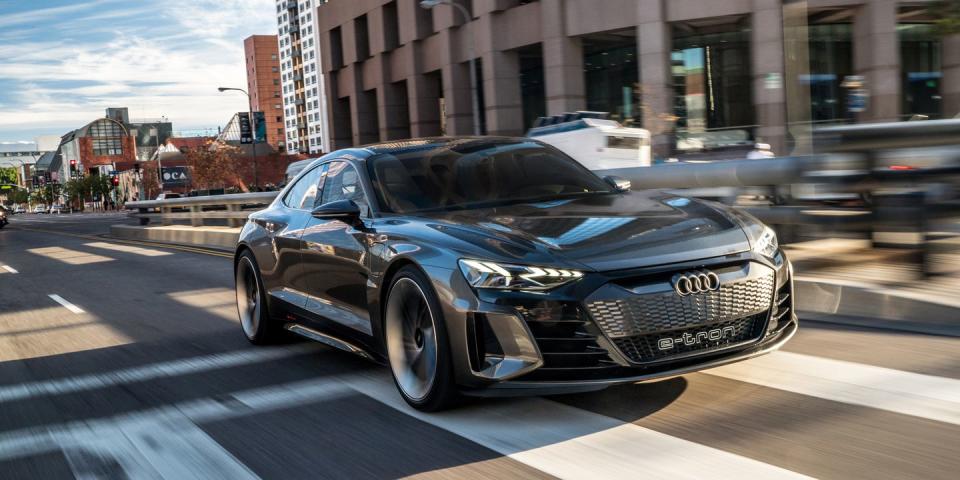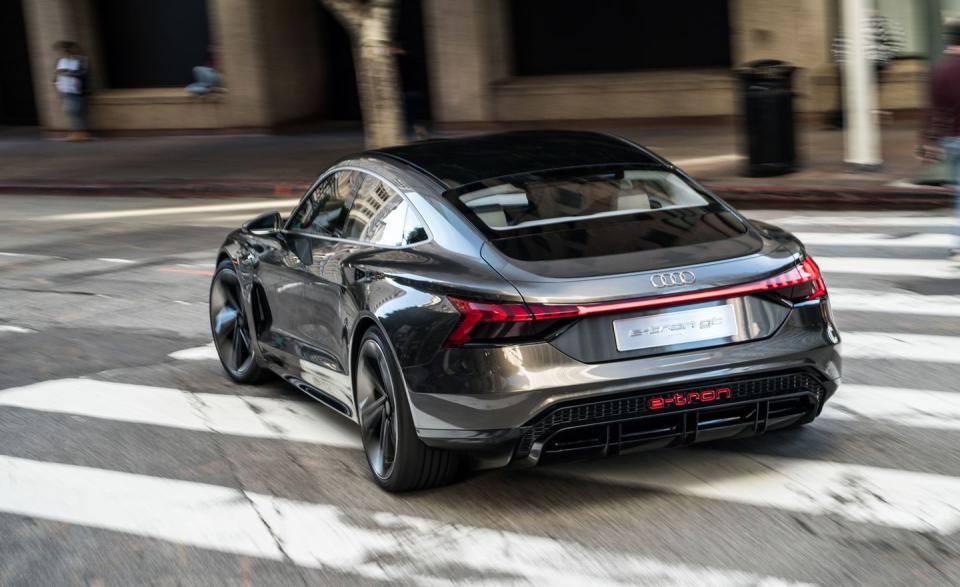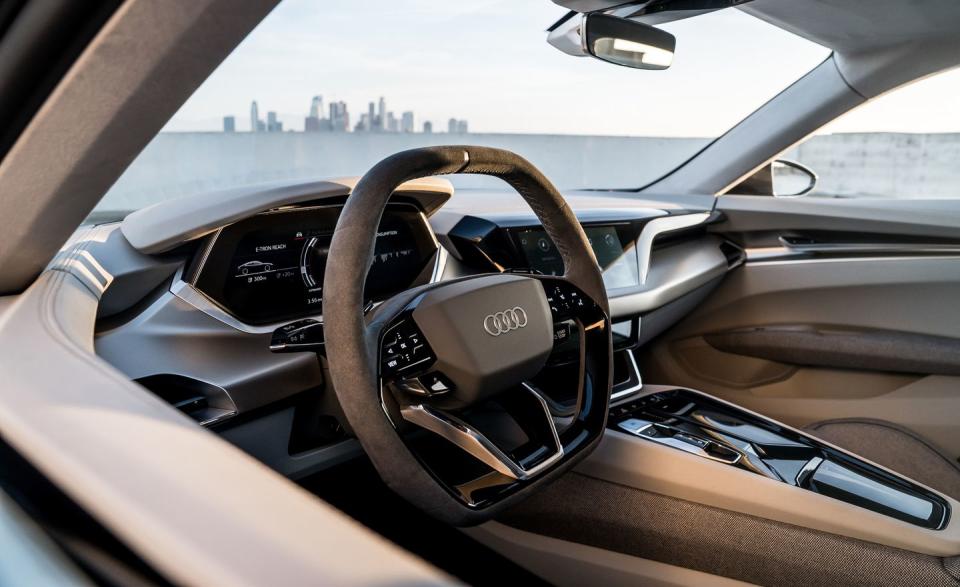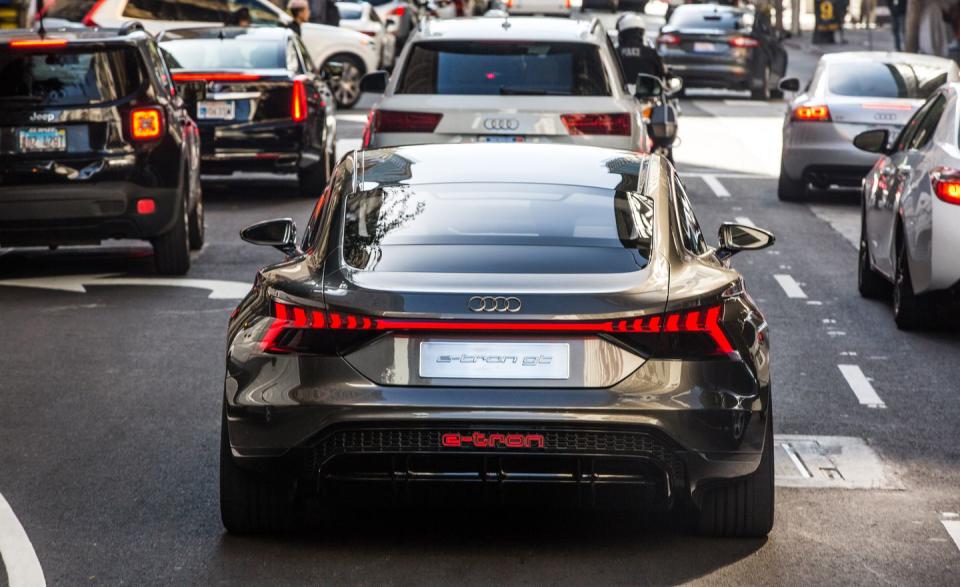Driving Audi's e-tron GT Concept Gives Us a Taste of the Brand's EV Future

According to Audi, the Audi e-tron GT concept represents the logical next step in the brand's effort to grow its presence in the EV segment. While there is truth to that statement, logic rarely arrives wrapped in such a seductive package. After a short, low-speed excursion behind the wheel, we'd say the e-tron GT concept is a four-door EV missile launched on a precise trajectory to invade a space previously dominated by Tesla. But we're getting ahead of ourselves.
On the stage at the Los Angeles auto show, the Audi e-tron GT concept cut a sleek profile and drew plenty of attention. The vehicle is being developed in conjunction with the upcoming Porsche Taycan EV. And the very car on the podium was the car we would pilot the next day on a short excursion through downtown Los Angeles.
Although we would have loved to verify its claimed 3.5-second zero-to-60-mph time and 249-mile range, our time behind the wheel was limited to low speeds over a short predetermined route. Audi went so far as to install a chaperone in the car with us to ensure that the fun meter registered little movement. Even so, we came away with some impressions.
First, the e-tron GT retains its star power in a real-world setting. It looks every bit as low and sleek on the city streets as it appeared the day before under the spotlights on stage. Onlookers gawked predictably, something they might have done even if we didn't have an escort convoy composed of a lead/photo vehicle and trio of motorcycle officers hired to keep the L.A. riffraff in their daily drivers from getting within striking distance of the e-tron GT concept's bodywork.
Entry through the front doors is a squeeze, considerably more than in the A7, which is close in size (the e-tron GT has a 114.0-inch wheelbase and is 195.6 inches long and 54.0 inches high). The interior features a modern, minimalistic approach and sustainably sourced fabric upholstery. Although the latter wore a protective cover, the bits we could touch felt as natural as any automotive textiles currently in production. Headroom is adequate for six-footers, and the view forward is similar to that in the A7. Back-seat room is tight, and Audi makes no attempt to pass off the rear compartment as accommodations for any more than two people. You can get comfortable back there, provided the front-seat occupants scoot their seats forward a bit.
Once settled in, we pushed the start button, selected drive, and moved out of a staging area in a parking garage and into the flow of traffic. The pair of non-adjustable rearview mirrors-it's a concept, remember-conspired with a large rear blind spot to make every lane-change maneuver a leap of faith. (Here again, the police escort proved its value.)
With a top speed of approximately 45 mph, we only had a few opportunities to delve into the 590 horsepower and the well of torque provided by the pair of electric motors. Suffice it to say that acceleration arrives with that same trademark EV swell of low-down thrust to which we've become accustomed in everything from the Chevrolet Bolt EV to the Tesla Model S.
The e-tron's regenerative brakes slow the vehicle and recapture energy during mild braking up to 0.3 g, while the ceramic-disc braking system comes into play when rapid deceleration is required. In practice, the braking feels reasonably natural and free of any obvious changes in the pedal travel or braking force as the friction brakes step in to assist stopping. There are three levels of regenerative coasting that can be controlled manually using paddles, or you can let the car control it automatically via a predictive efficiency-assist system, which attempts to guess your next move and plan for maximum regenerative effect.
With speeds kept in check and a chaperone guiding us, we only received cursory exposure to these functions. The same goes for exercising the car's four-wheel-steering system and its torque-vectoring capability. The ride was rather trucklike, and even medium-size pavement imperfections resulted in very un-production-car-like noises echoing throughout the structure. Part of that can be attributed to its 22-inch wheels with low-profile 285/30 tires, but it was clear that this mule is a few kicks short of a final production vehicle.
What we took away from the brief experience is that Audi is dedicated to the EV segment, and the company's desire to get us behind the wheel of this concept served as a dynamic demonstration that this is not some flight-of-fancy show car that will be rolled into a dark warehouse at the end of the auto-show season and never heard from again. This is a genuine Tesla fighter in the final stages of gestation. By the time the fully baked e-tron GT comes to market in late 2020, things will be getting very interesting in the EV market.
('You Might Also Like',)

 Yahoo Finance
Yahoo Finance 


